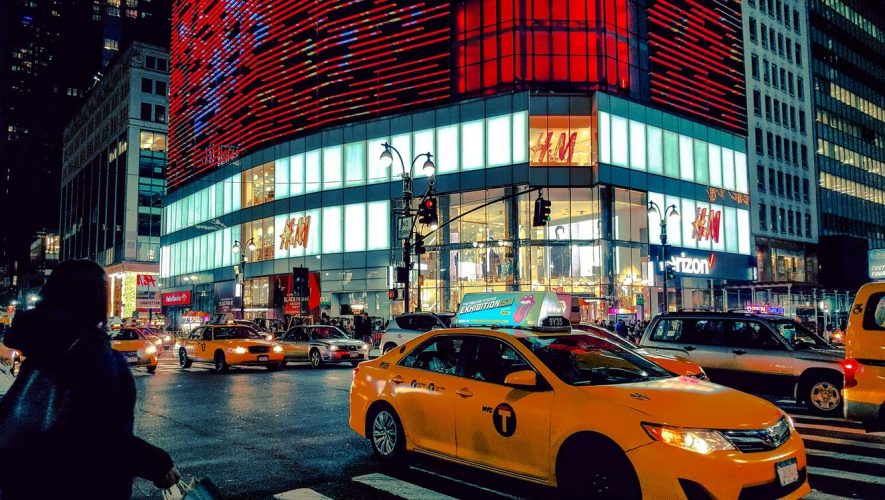On March 24, Uber announced that it would add NYC taxicabs to its app this summer to increase user accessibility. This partnership, referred to as the “yellow cab deal,” kills two birds with one stone: it creates new customers for cab drivers while simultaneously tackling Uber’s driver shortage. Though the deal appears to revive the once-doomed taxicab industry, it actually bolsters Uber’s reputation at taxi drivers’ expense: Uber preys on cab drivers who are willing to work for less and undermines existing labor movements to improve working standards for all Uber drivers.
This isn’t the first time Uber tried to downplay its negative impact on the taxi market, especially in New York City. Uber denies that the rise of ridesharing apps reduced the value of taxi medallions and refuses culpability for the troubling increase in cab driver suicides that followed. The yellow cab deal only builds upon this trail of destruction.
The Rise and Fall of NYC Taxicabs
In the years before ridesharing apps gained popularity, the NYC taxi industry was lucrative. In the golden age of taxicab driving, many drivers traded taxi medallions, which are transferable permits for operating a yellow taxi. Low-income, middle-class, and immigrant families viewed taxi driving as a safe investment in economic stability, increasing the value of NYC taxi medallions to over one million dollars. Today, however, the value of a taxi medallion has dropped to around one hundred thousand dollars, making the industry less profitable and putting those with medallion mortgages at a severe disadvantage.
Analysts attribute this rapid depreciation to the growing abundance of rideshare services in urban areas—including, most notably, Uber, which launched its services in New York in 2011. Within five years of Uber’s NYC debut, medallion prices fell by 50 percent.
Many cities across the US protect local taxicab industries from competition and Uber entered these markets with aggressive and legally questionable business tactics. For instance, Uber provided first-time passengers with free rides worth up to $25 to avoid violating existing city agreements with payment processors, but wouldn’t answer questions about how they planned to handle more expensive rides. By testing the limits of local laws, Uber pushed through just enough to gain traction and assert its competitive advantage. Uber also launched a series of persistent lobbying campaigns to get their cars onto city streets. Eventually, lawmakers voted in support of ridesharing operations.
These market disruptions disempowered drivers who still had mortgages to pay off on their medallions. With significant losses in income and worthless permits, rideshare companies left cab drivers with no money, no options, and no hope. In 2018, eight NYC cab drivers committed suicide over the span of eleven months. In 2021, NYC taxi drivers spent weeks on a hunger strike to advocate for greater debt relief by the city. Drivers that work tirelessly for limited wages are pushing themselves to the brink because of how quickly and mercilessly the industry collapsed on them.
In defense of the taxicab industry, former NYC mayor Bill de Blasio claimed in 2018 that Uber became an unregulated “corporate giant” at the expense of the general public. Uber responded to this claim with a public relations campaign against the mayor, employing lobbyists and elected officials to take a united stance against him. These attacks were highly effective and showed Uber’s growing political influence.
Despite de Blasio’s statements, Uber’s supporters argue that Uber provides value for the average consumer, bringing newer technology, greater convenience, increased safety, and lower fares for long rides, which are typically trips below $35.
However, these perceived benefits are just that: perceived. Cab drivers are subject to more thorough background checks than Uber drivers and cab rides tend to be cheaper for shorter rides, the most common type of trip. In terms of convenience, you can call a taxi the same way you would book an Uber—with your phone.
Uber, Lyft, and other ridesharing companies antagonized the taxicab industry, allegedly to promote convenience and affordability for consumers, but ultimately putting low-income and unprotected drivers at a disadvantage. Left vulnerable, medallion-owning drivers have no choice but to agree to Uber’s yellow cab deal despite its significant drawbacks.
The Yellow Cab Deal
Uber’s yellow cab deal will integrate NYC’s existing yellow cab apps, Curb Mobility and Creative Mobile Technologies, with its own software to give consumers the option to select a yellow cab. Although the deal appears mutually beneficial, it has the potential to create issues for consumers and drivers.
For instance, the push to include taxicabs on the Uber app may disrupt cab fares. Currently, Uber and other ridesharing companies use a dynamic pricing model with a surcharge during periods of increased demand. Once the partnership officially goes into effect, taxicabs will also begin to adopt a demand-based pricing model, potentially skyrocketing prices when consumers need a ride the most.
Moreover, Uber will pay cab drivers according to the same commision-based compensation model as for existing Uber drivers. Under the Uber fee, drivers pay a proportion of their fares to the company. By forcing cab drivers to pay the Uber fee alongside their unique medallion and leasing costs, Uber leaves them with lower wages.
Uber’s Financial Gains
With rising operating expenses and a decline in revenue, taxicab drivers already struggle to stay afloat. Uber, conversely, is seeing huge gains. When the agreement was first made public in March, Uber’s shares rose five percent. The yellow cab deal launched towards the end of this year’s first fiscal quarter, so many of the immediate and long-term impacts of this partnership cannot be fully assessed.
Despite these gains, Uber plans on elevating the “user experience” rather than improving driver benefits, like raising wages, to address their driver shortage; instead of paying workers more, the yellow cab deal lets Uber manipulate the workers that they had previously put at a disadvantage.
The yellow cab deal is a strategy that Uber will continue to use in the future. In Uber’s announcement, they claimed that they plan on including every taxi on their app by 2025 and added 122,000 new taxicabs to the app in 2021. The inclusion of taxicab services may boost Uber’s financials, but it dismisses the concerns of Uber employees and cab drivers in NYC and beyond.
Labor Campaign Concerns
News of Uber’s alliance with the NYC taxi industry has conveniently drawn attention away from labor campaigns that threaten their bottom line. The campaigns’ main criticisms of Uber’s labor practices revolve around the inability of drivers to join labor unions and receive typical employment benefits, such as basic healthcare. Uber gets away with denying their drivers full-time benefits by hiring only flexible-time drivers, a characteristic of the gig economy.
A 2018 study conducted by the Economic Policy Institute found that Uber drivers are undercompensated and often receive wages of around 9.21 dollars per hour. Groups like NYC-based Justice for App Workers fight against the exploitative nature of ridesharing companies and do not believe that the yellow cab deal will be used in the best interests of cab drivers.
In addition to Uber drivers and other ridesharing workers, taxi drivers in New York immediately voiced their concerns about the yellow cab deal when it was announced. According to a statement by the New York Taxi Workers Alliance (NYTWA), Uber’s current cost structure fails to appease their own drivers and cannot, as it stands, serve the needs of cab drivers. Bhairavi Desai, the executive director of NYTWA, points out that cab drivers deal with higher car costs and a stream of medallion payments, both of which cannot be covered by Uber’s existing business model.
The NYTWA requests that Uber implements a fuel surcharge for all NYC drivers (not just standard Uber drivers), adjusts driver payment rates to account for varying operating costs, and secures both Uber and yellow cab drivers from dismissal without warning under Just Cause protections. Uber and Lyft members have begun to join the NYTWA in their pursuits, joining the #RaiseforAll Drivers Campaign.
Uber’s yellow cab deal is still in its early stages. As it officially launches, its actual consequences on consumers and cab drivers can be more clearly observed and addressed by labor campaigns, government officials, and the general public. The forecasted impacts of this partnership paint the yellow cab deal as a ploy for Uber to cut costs under the guise of creating a better world for the taxi industry.



